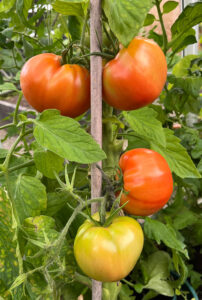With it is warm and sunny, sow trays, pots or old growing bags with ‘cut and come again crops’ to harvest through autumn and into winter like Land cress, oriental salads, like pak choi, mizuna and mibuna greens, lettuce, lamb’s lettuce, carrots for seedlings, chicory and radish. You can also use what’s left from earlier brassica sowings and you harvest them earlier as microgreens.
Reduce watering and damping down as temperatures drop. Early in the month take semi-ripe cuttings from tender plants like pelargoniums and salvias for overwintering. Put several around the edge of a pot of 50:50 mix of peat free multipurpose compost and vermiculite for rapid rooting and cover with a polythene bag to maintain humidity or put them in a propagator, keeping the compost moist. They should be rooted and ready for potting on in two to three weeks and spend winter in a frost-free greenhouse.

Towards the end of the month, lift and pot up tender plants for frost free overwintering, drench with nematodes to ensure they are vine weevil free.
Check the greenhouse heater to make sure it is working before the first frosts and your rolls of bubble wrap tears, re-ordering and replacing if needed and make sure you have plenty of fixing accessories. Once you have insulated the greenhouse use the leftovers for wrapping pots that stay outdoors for winter.
There are ‘pro’s and con’s’ to insulating the greenhouse with bubble wrap. There needs to be a balance between the amount of available light, heat conservation and ventilation. If you live where winters are usually mild, (though it is hard to predict, these days) you may want to gamble and not insulate at all. As there is a possibility of cold spells or a cold winter like the one we experienced in UK last year, listen to the weather forecast and have the heater and protective layers of newspaper or horticultural fleece on standby.
Full insulation reduces the amount of light entering the greenhouse, increases humidity encouraging fungal problems and holes have to be cut so the vents can be opened on warmer days. It is a real ‘faff’ takes ages and in common with many gardeners, is one of my least favourite jobs.
However, there are alternatives, especially given the rising cost of electricity. One is to divide the greenhouse into two sections; with and without heating, for plants with different requirements, separating the spaces with a curtain of fleece or bubble wrap. I have also successfully overwintered tender plants in trays under a greenhouse bench draped with several layers of horticultural fleece but as with many overwintered plants, it is essential that the compost remains dry. Another adaptation is to extend the area heated by your propagator by making a frame of bamboo canes, (as you would for brassicas) covered with fleece with the tender plants inside. Those with a greater degree of tenderness can go on the heated pad, those tolerating lower temperatures can be further away. Where possible, reducing the height of plants reduces the volume of air and makes heating more effective. Happy Gardening, Matt.


